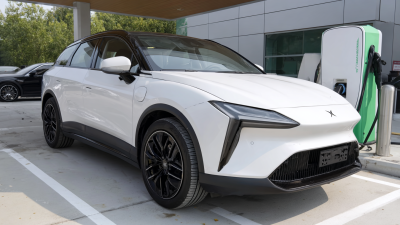Leave Your Message
As the automotive industry continues to evolve, the Battery Car market has witnessed significant growth, driven by technological advancements and increasing consumer demand for sustainable transportation solutions. According to a report by the International Energy Agency (IEA), global electric car sales surged to over 6 million units in 2021, marking a 108% increase compared to the previous year. This remarkable shift towards electric vehicles signifies not only a change in consumer preferences but also the urgent need for individuals to make informed choices about their vehicle purchases. As more options become available, understanding the essential factors in selecting the right Battery Car for your specific needs is crucial.

This blog will explore five key tips that can help potential buyers navigate the complexities of this burgeoning market, ensuring they find a vehicle that aligns with their lifestyle and sustainability goals.
When it comes to selecting the right battery electric vehicle (BEV) suited to your needs, understanding the types available on the market is crucial. The EV insurance sector is projected to witness substantial growth, with the market size expected to reach approximately $33.8 billion by 2030, up from $25.3 billion in 2022. This growth is driven by an increase in both passenger and commercial vehicle segments, underscoring the rising demand for insurance tailored specifically for electric vehicles.

In a related development, the automotive HVAC market, which plays a pivotal role in passenger comfort, is also expanding. It is anticipated that the HVAC market for electric vehicles will see significant advancements, with the market size estimated to grow considerably by 2032. This expansion reflects the increasing integration of sophisticated climate control systems, particularly in hybrid and fully electric models. Additionally, with China dominating the electric vehicle battery casing market, projected to grow from $5.76 billion in 2024 to $15.96 billion by 2032, it becomes evident that proper understanding of both the mechanical components and the insurance landscape is essential for any potential EV owner.
When choosing the right battery car, it's crucial to consider the key features that align with your driving habits. One of the primary factors is range. If you primarily drive short distances, a model with a lower range might suffice, but for those who frequently embark on longer trips, investing in a battery car with an extended range is essential. Understanding your daily travel patterns will help narrow down your options significantly.
Another important consideration is charging infrastructure. Evaluate whether you have convenient access to charging stations at your home, workplace, or along your typical routes. The type of charging options available—like standard home chargers versus fast-charging stations—can greatly influence the overall convenience of owning an electric vehicle. Additionally, consider the vehicle’s storage capacity and technology features, such as regenerative braking and smart infotainment systems, that can enhance your driving experience. Choosing a battery car tailored to your specific needs will ensure you enjoy the transition to electric driving.
This chart displays five essential features to consider when choosing a battery car based on average user preferences.
When choosing the right battery car, evaluating the range and battery life is crucial to ensure it meets your lifestyle and driving habits. The first step is to consider your daily commute and typical driving distance. If you generally drive within a 50-mile radius, a car with a range of 150 miles should be more than sufficient. However, if you frequently embark on longer trips, opting for a vehicle with an extended range of 250 miles or more can provide peace of mind and flexibility.
Another important consideration is battery life and charging options. Look for cars with warranties that cover battery longevity, as this can be a significant investment. Additionally, check for charging infrastructure in your area. If you have access to home charging, the convenience of overnight charging can greatly enhance your driving experience. Aim for a car with fast-charging capabilities to reduce downtime during long journeys, allowing you to recharge while taking a break.
Lastly, read reviews and user experiences focusing on battery performance over time. This information can give you insights into how the battery holds up under various conditions and whether it meets the needs of real-world drivers. By taking these factors into account, you can make an informed decision that aligns with your requirements.
When it comes to selecting the right battery car, understanding the balance between cost and value is paramount. The initial price of a battery electric vehicle (BEV) can often deter potential buyers, but evaluating the long-term value is essential. Factors like maintenance costs, fuel savings, and government incentives can significantly offset the up-front investment. For instance, many countries offer tax rebates or grants for electric vehicle purchases, which can effectively reduce the overall cost and enhance value.

Another aspect to consider is the total ownership experience. Battery cars tend to have fewer moving parts compared to traditional vehicles, which translates to lower maintenance costs over time. Moreover, with rising fuel prices, the savings from not buying gasoline can be substantial. When choosing a battery car, it’s crucial to project how long you plan to keep the vehicle and calculate potential savings against the initial cost. By focusing on the value proposition rather than just the price tag, buyers can make more informed decisions that align with their long-term needs and budgets.
When choosing a battery car, one of the most crucial considerations is the charging options available. Understanding the differences between home charging and public infrastructure can significantly affect your owning experience. According to the International Energy Agency (IEA), around 90% of EV charging is done at home, making it essential to gauge your home setup. A Level 2 home charger can provide up to 25 miles of range per hour, which is more than adequate for most daily commutes. This convenience comes with the added benefit of charging overnight when electricity rates are often lower.
Conversely, public charging infrastructure plays a vital role, especially for long-distance driving or in urban environments where charging at home isn't feasible. In the U.S., the Department of Energy reported there are over 100,000 public charging stations, with fast chargers delivering up to 80% battery capacity in just 30 minutes. This network is vital for anyone considering a battery car, as it provides flexibility and peace of mind on longer trips. Ultimately, assessing both home and public charging options will help you determine the best battery car to suit your lifestyle and driving habits.
| Charging Option | Advantages | Disadvantages | Ideal For |
|---|---|---|---|
| Home Charging | Convenience, Cost-effective, 24/7 availability | Requires installation, Limited by home location | Daily commuters, Homeowners |
| Public Charging Stations | Wide accessibility, Fast charging options | Potential wait times, Cost variability | Long-distance travelers, City dwellers |
| Workplace Charging | Accessible during work hours, Encourages EV adoption | Dependent on employer, Limited availability | Employees with access, Companies promoting sustainability |
| Fast Chargers | Rapid charging, Great for road trippers | Higher cost, Limited locations | Travelers needing quick top-ups |
| Level 2 Chargers | Good for overnight charging, Compatible with most EVs | Slower than fast chargers, Requires installation at home | Home users, Apartment buildings |






